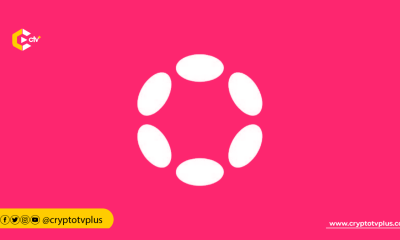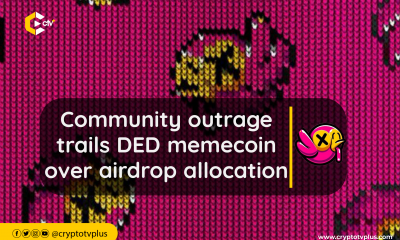Polkadot
Understanding the Polkadot Blockchain

Polkadot (DOT) is a distinctive blockchain that takes pride in delivering interoperability amongst other blockchains. Polkadot is one of the very few blockchain networks designed around the philosophy of creating various smaller inter-connected sub-chains within the umbrella of a single blockchain on top.
In this article, we are going to have a rudimentary look at this quirky ‘network of networks’.
What is Polkadot?
Polkadot was founded by Gavin Wood(a co-founder of Ethereum) alongside Peter Czaban and Robert Habermeier in 2016. Gavin Wood invented Solidity(the language used by developers to write decentralized applications on Ethereum).
He was Ethereum Foundation’s first CTO and an instrumental member of the Ethereum developer team before he left the Ethereum project in 2016 because he did not think the firm was doing enough to pursue the promise of blockchain technology- a truly decentralized ecosystem.
Polkadot rolled its mainnet launch out in stages instead of a one-time launch. It was divided into phases that introduced various functions to the mainnet. The five phases were all released in 2020 with the final one in August 2020. The nonprofit Web3 Foundation is the primary research organization that maintains Polkadot’s open-source code.
Polkadot is a software that seeks to incentivize a global network of computers to operate a blockchain on top of which users can launch and operate their own blockchains.
In this connection, Polkadot is amongst a number of competing blockchains looking to grow an ecosystem of cryptocurrencies, other notable examples of which include Ethereum (ETH), Cosmos (ATOM) and EOSIO (EOS).
Polkadot is designed to operate two types of blockchains. A main network, called a relay chain, where transactions are permanent, and user-created networks, called parachains.
Parachains can be customized for any number of uses and fed into the main blockchain, so that parachain transactions benefit from the same security of the main chain. With this arrangement, transactions can be kept secure and accurate using only the computing resources required to run the main chain.
Users also gain the added benefit of being able to customize many parachains for many different uses. The Polkadot team believes this design will let its users perform transactions more privately and efficiently, creating blockchains that don’t disclose user data to the public network or that otherwise process a greater number of transactions.
Polkadot’s $DOT token currently ranks 10th on Coinmarketcap. This utility token provides governance, bonding and staking functions in the network. The governance function allows DOT holders to exercise control over the Polkadot network.
DOT holders can determine the network’s operating fees, auction dynamics and schedule for adding new parachains. They can also decide when it may be necessary to execute upgrades on the platform.
How Polkadot Works
The Polkadot platform works with a relay chain that uses a variation of the Proof-of-Stake Consensus Algorithm. The DOT token gives the validators a voting power that enables them to take part in the decisions and evolution of the project.
Moreover, the DOT token can be used to link and incentivise the validators to act with honesty in the network when having a financial interest in the authenticity of the verification process.
This system allows anyone who stakes DOT by locking the cryptocurrency in a special contract to perform one or more of the following roles necessary to its operation:
- Validating roles: they validate the data in the parachain blocks. They also participate in the consensus and vote about the changes proposed in the network.
- Nominating roles: they protect the relay chain selecting trustworthy validators, and they delegate the DOT tokens they have bet to the validators. This is how they assign their votes.
- Collecting roles: nodes that store a complete record for every parachain and add data about the transactions of the parachains in blocks to add them to the relay chain.
- Fishing roles: they perform the monitoring on the Polkadot network and report bad behaviors to the validators.
Consensus Algorithm
Polkadot uses a more modern consensus(mechanism) protocol in the Nominated Proof-of-Stake algorithm. This is designed to maximize the network’s shared security so that no users’ parachain is corruptible.
Nominated proof of stake allows those staking DOT tokens to nominate validators they feel will best serve and secure the network. Unlike the similar delegated-proof-of-stake system, NPoS makes it possible for nominators to be subjected to a loss of stake if they nominate a bad actor.
Polkadot’s TPS
In the context of blockchain, transactions per second (TPS) refers to the number of transactions that a network is capable of processing each second. Many ‘big names’ blockchain cannot scale because they cannot handle a lot of traffic.
Bitcoin only allows 7 transactions per second (tps) while Ethereum allows for 15-20tps. Visa, for example, can process a maximum of 65,000tps, Its max tps is 9.285 times faster than Bitcoin and actually processed tps 248 times faster than Bitcoin.
However, Polkadot Network can support around 1,000 transactions per second, a significant improvement over Ethereum’s 13 transactions per second. Gavin Wood has also proclaimed that it is very much feasible for Polkadot’s transaction speed to be 1 million tps.
Ethereum 2.0, the successor to Ethereum, is projected to have 100.000 tps. So if these projections stay consistent through its stages of development, Polkadot’s transactions per second will be top tier and highly competitive, if not the absolute fastest, in the crypto ecosystem.
Read Also
XPLUS: Exploring the World’s Leading Digital Asset Trading platform
Where To Buy & Sell Polkadot
Binance
Binance is arguably the largest and most popular cryptocurrency exchange in the world. The benefits of purchasing Polkadot (DOT) here is that you benefit from the lower exchange fees than competing exchanges, and the increased liquidity enables traders to buy and sell quickly to take advantage of market moving news.
Gate.io
Established in 2013, Gate.io has grown into a reputable trading platform. While it is not the most popular exchange, it provides users with an easy to use interface for beginners while maintaining robust and advanced charts for various skill levels – including technical traders.
The exchange boasts a large number of altcoins including Polkadot (DOT), and is often the first exchange to add new tokens. Notably, Gate.io maintains a strong stance against any type of market manipulation.
Kucoin
KuCoin is a well-known name in the industry, and one of the most competitive in the sector when it comes to fees and trading costs. The exchange has grown exponentially from the early days of offering only crypto to crypto trading and they now offer a varied range of services including a P2P exchange capability, and purchasing with credit or debit cards.
They currently offer Polkadot (DOT) cryptocurrency trading as well as over 300 other popular tokens. They are often the first to offer buying opportunities for new tokens.
What do you think of this article? Let’s hear from you in the comment section!

























Pingback: Understanding the Polkadot Blockchain by Temitope Akintade – CryptoTvplus Events: NFT, DeFi, Bitcoin, Ethereum, Altcoin Events
Pingback: Exeedme; The PlayToEarn platform that bridges Web2.0 and Web3 – Crypto Watch Daily
Pingback: 7 عملات مشفرة عليك شرائها إذا كان لديك 100 دولار فقط لإنفاقها – CryptoBeezer عرب
Pingback: 7 криптовалют, які ви повинні купити, якщо у вас є лише 100 доларів – CryptoBeezer Україна
Pingback: 7 criptomoedas que você precisa comprar se tiver apenas $ 100 para gastar – CryptoBeezer brasil
Pingback: 7 kriptovaliutos, kurias turite nusipirkti, jei turite tik 100 USD – CryptoBeezer Lietuva
Pingback: 7 crypto-monnaies que vous devez acheter si vous n’avez que 100 $ à dépenser – CryptoBeezer La France
Pingback: 7 kriptovalūtas, kas jums jāiegādājas, ja jums ir tikai 100 USD, ko tērēt – CryptoBeezer Latvija
Pingback: 7 Must-Buy Cryptos if You Only Have $100 to Spend – TheHodlGuys.com
Pingback: Understanding the Polkadot Blockchain | CryptoTvplus: DeFi, NFT, Bitcoin, Ethereum Altcoin, Cryptocurrency & Blockchain News, Interviews, Research, Shows – CryptoBullNewsflash
Pingback: SEBA Bank allows Ether staking | CryptoTvplus: DeFi, NFT, Bitcoin, Ethereum Altcoin, Cryptocurrency & Blockchain News, Interviews, Research, Shows
Pingback: How Teddy DAO will use NFT for social good | CryptoTvplus: DeFi, NFT, Bitcoin, Ethereum Altcoin, Cryptocurrency & Blockchain News, Interviews, Research, Shows